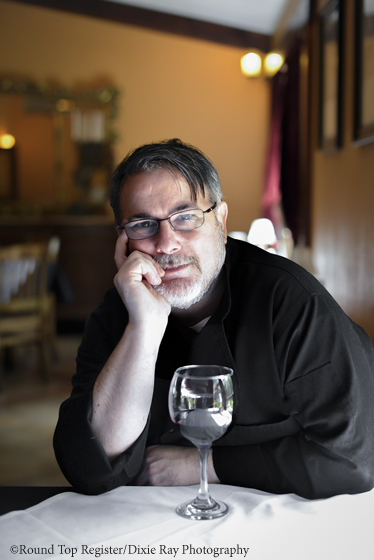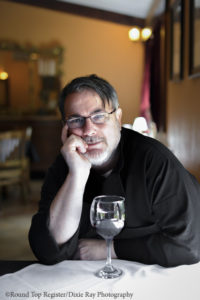Volare Italian Restaurant in Brenham

2024 Spring Antiques Show | March 14 – 31
2024 Fall Antiques Show | October 10 – 27
The first time I met Silvio DiGennaro, the chef-owner of Volare, the lunch rush was winding down. The serenity of the historic home that houses the restaurant was a respite from the hectic pace of the fall antiques show. Silvio came to my table just as I was preparing to lick the last of the parmesan and garlic-infused cream sauce off my plate. (There was also some chicken, bacon and slurp-ready al dente pasta involved.) It was an honor to shake the hand of the man responsible my for my blissful carbohydrate nirvana. Unbeknownst to me at the time, DiGennaro is a native of Matera, Italy. His accent was an unexpected treat deep in the heart of Texas. (He also speaks Spanish and French as well as English and Italian.) His accent is, as I quickly came to understand, perfectly in context within Volare, where DiGennaro celebrates the Italian passions of food, wine, family and friends.
Key Ingredients
Volare Restaurant
102 South Ross St.
Brenham, TX 77833
979-836-1514
www.volareitalianrestaurant.comHours
Lunch
Tuesday – Saturday 11 AM to 2 PM
Dinner
Tuesday – Thursday 5 to 9 PM
Friday – Saturday 5 to 9:30 PMVolare, just blocks from historic downtown Brenham, specializes in authentic Italian dishes influenced by the warm flavors of the Matera countryside that have been adapted to deliver the bold flavor profile Texans expect. Lunch is casual while the dinner service features a more extensive menu as well as linen tablecloths and candlelight.
Reservations are available by phone or online except during the final week of the spring and fall Round Top Antiques Shows.
An extensive wine list featuring domestic and imported wine is available.
The Recipe for Volare Italian Restaurant
DiGennaro, who as a young chef owned and operated three restaurants in Italy, visited Houston in 1992. He fell in love with a Greek girl who had a big family. He closed his Italian restaurants, crossed the Atlantic and made a multi-cultural life in Richmond, Texas, where he continued to work in restaurants.
His then-wife’s grandparents had a country home in Burton that was the site of all extended family celebrations, including Greek Easter. When his former in-laws announced they were moving to Burton, the DiGennaros, who have since divorced, decided to move to the country to be near extended family.
En route to Houston after a celebration, they veered from their regular trail and stopped in Brenham for the first-time. Traveling with a baby in the car, they normally attempted to get home quickly.
On this stopover, DiGennaro spotted a restaurant for rent. One day later he visited the location of the former Ant Street Saloon, negotiated a lease, and soon after began transforming the Texas-centric space, decorated with taxidermy, automatic weapons and beer signs, into an outpost of Italy.
In 2005, the restaurant moved to its current location, where a historic “salt box” house provides a comfortable, intimate atmosphere.
From the beginning, quality mattered. Key ingredients such as pasta, tomatoes and olive oil are imported from Italy. DiGennaro is a hands-on chef-owner. Initially, he couldn’t afford bread-making equipment, so he got to the restaurant at 4 a.m. to hand-make the 400 rolls he serves daily. These days, he takes advantage of technology to mix and knead but still makes the bread fresh daily.
Although he is a long-time restaurateur, DiGennaro’s vocation is also his avocation.
“They say music is the universal language, but it doesn’t bring people together around a table like food does,” he said. “Cooking is easy—anybody can cook. The difference is the passion and the patience you bring to the process.”
RTR: Who taught you to cook?
SDG: Our family revolved around food. We would discuss what we were going to have for dinner while we were eating lunch.
My mother was a German-speaking Austrian. She cooked heavy food influenced by her life in the Alps, where people needed hearty meals like stew with liver to survive working outdoors in the winter. She made fresh sauerkraut, and our house would smell like vinegar for weeks. My father was from Naples, so he grew up with the light flavors of seafood and fresh mozzarella. He made dishes such as calamari and fresh green peas.
At our table, I learned about conversation and compromise. My parents had different food traditions, but they respected the flavors of the other. Christmas was something to behold because my mom cooked from both sides of the family.
RTR: So your parents taught you to cook?
SDG: Yes and no. By the time I was 13, my dad decided I needed a job to keep me out of trouble, so he apprenticed me to a local baker for no money. I worked there a year and then figured out that I should get paid for working that hard, so I got a job at another bakery. In the beginning, I had to write down recipes, but then the knowledge just become part of who I am.
RTR: How is the food culture of Italy different than America?
SDG: Food is part of the social structure of Italy. I remember that the postino [postman] was always late because he had to stop in almost every house for an espresso or a bite of dolce [sweets]. A woman delivered eggs still warm from the chickens to our house three times a week. When we kids were sick, the doctor would make house calls. If our illness wasn’t serious, he’d sit in the kitchen sipping wine and laughing with my parents before coming to check on us.
RTR: If you could only eat one food for the rest of your life, what would it be?
SDG: Pasta. That’s easy. Choosing the sauce would be hard. Probably something with tomatoes and good olive oil.
RTR: What food will never cross your lips?
SDG: Canned spinach. When I came to America, I wanted to eat spinach like Popeye. I even tried to squeeze the can. It was awful. I also once scraped all of the condiments off a McDonald’s hamburger and just tasted the patty. Never again.
RTR: Food pet peeve?
SDG: People who put ketchup on food, especially when they don’t even taste it.
RTR: Your dog-eared cookbook?
SDG: My three brothers are all chefs as well. In Italy, chef school was free. I have the first book that teaches all the basics—and it was used by each of us. It holds a lot of memories for me.
RTR: What do you wish people understood about the restaurant business?
SDG: All chefs have their own styles, flavors and methods of preparation. You shouldn’t expect the food to taste exactly the same from restaurant to restaurant unless you’re eating at a chain. Respect the perspective. Try new things.
RTR: Do you eat out at other restaurants?
SDG: Every chance I get: Mexican, Indian, Ethiopian, Chinese and the rest of the world’s offerings. I’m a good customer because I understand the challenges of the restaurant business. I rarely send a dish back, instead I add Tabasco® Sauce because it masks all the flavors.
RTR: Blue Bell or gelato?
SDG: Blue Bell is good, but for me, gelato. When my daughter and I went to Italy over the summer, our goal was to eat gelato twice a day. In Italy I had a gelato store with 45 flavors like fresh tangerine and black cherry. Every night we melted the remaining product in the refrigerator and re-whipped it the next morning so it would be fluffy and fresh.
RTR: Wine, beer or cocktail?
SDG: Wine to complement food, beer to refresh on a hot day and cocktails to socialize.
RTR: Red or white?
SDG: Depends on the food. It matters. One time I bought a good branzino fish and baked it simply with herbs. I had a Barolo on hand, and it sounded good but tasted horrible with the fish. I knew better. I ate the fish that night and recorked the Barolo and drank it the next night with something else.
RTR: Best meal you’ve ever eaten?
SDG: It would have to be a meal with my Italian family, maybe a holiday meal. Most recently, though, my oldest daughter and I had dinner with my niece and her fiancé in a basement restaurant in Florence. I ordered like a crazy man. If someone said they’d like to try something, I ordered it. We ate good food, drank good wine and laughed. Good meals aren’t just about the food; they’re about the people and the memories.
Out of Bounds
The restaurant, especially at night, conjures up romance. At the risk of crossing personal boundaries, I just had to ask. . . .
RTR: So is there a romance in your life?
SDG: For three years there was, but sadly now it has gone. This special woman was my important true love. Inside me, though, the romance and the love lives on.
A Volare Favorite
Agnello Materano
As with many authentic Italian recipes, the goal is a balance of flavors. DiGennaro prepares this specialty based on his personal taste and experience. This “recipe” provides the general guidelines for his signature dish. DiGennaro suggests coming to dinner at Volare to taste the original.
As you grill the one-inch thick lamb chops to medium rare (internal temperature 140° – 145°, begin preparing the pan sauce. In a sautée pan, melt butter and add chopped fresh garlic and the mushrooms of your choice. (At the restaurant, DiGennaro uses button mushrooms, but suggests crimini or portabello for a more intense mushroom flavor.) Sautée mushrooms until they soften being careful not to scorch garlic. Add good quality balsamic vinegar and a bit of white sugar; reduce slightly to thicken and then add demi glace. Finish with fresh, chopped tarragon. When lamb chops reach desired doneness, coat the chops in the sauce, and allow them to rest in the sauce to absorb its flavor.
by Lorie Woodward Cantu
photos by Dixie Hamilton, Dixie Ray Photography
2024 Spring Antiques Show | March 14 – 31
2024 Fall Antiques Show | October 10 – 27